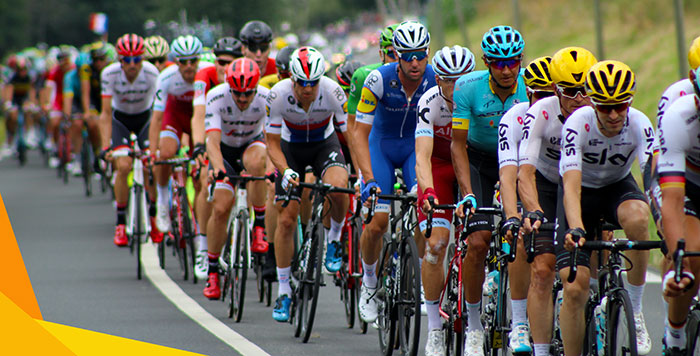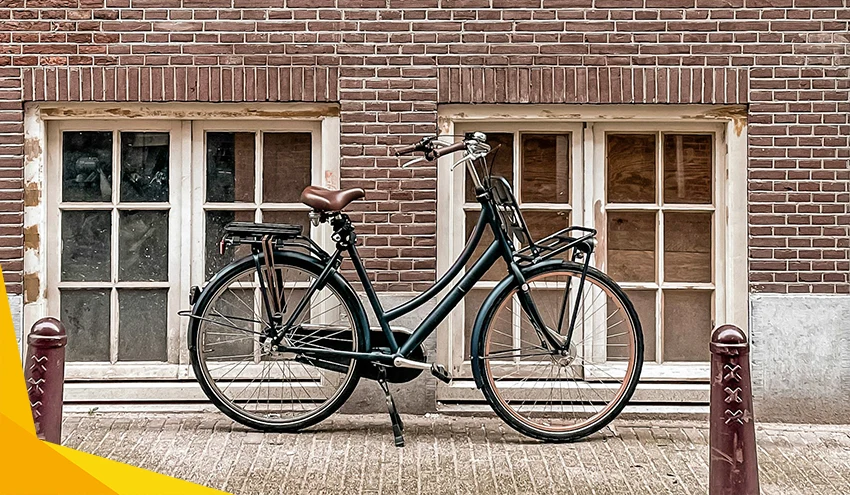Cycling is one of the most famous and popular sports in the entire world. From Colombia to South Africa, and the United States to Australia. Millions of fans tune into the Grand Tours every year.
Giro d’Italia, Tour de France, and Vuelta a España are some of the best-known cycling events that take place every year. For three weeks, riders battle it out across the Alps, Dolomites, and Pyrenees to claim some of the most coveted jerseys in cycling.
There is so much more to cycling than just the Grand Tours. The Monuments, World Championships, and Olympics are some of the marquee events.
And we haven’t even mentioned the other disciplines yet! Mountain biking, track cycling, and BMX racing host a number of World Championship events, as well as being included in the Olympics every four years.
These are the biggest events in all of cycling.
Grand Tours
The three Grand Tours are well-known events in cycling and have been around for over 75 years. These are the toughest races in cycling, and some of the toughest events in the world because of their relentlessness.
Every day for three weeks (with typically two rest days), the peloton races 4-6 hours per day over all kinds of terrain and in all kinds of weather.
The race hardly ever stops apart from extreme weather conditions. Riders are punished day after day for nearly a month.
At the end of each Grand Tour, there are a few different prizes awarded:
- General Classification (GC): best or lowest overall time
- Sprint or Points Classification: most cumulative points in intermediate sprints and finishes
- KOM (King of the Mountain): most points accumulated on classified climbs
- Best Young Rider: best overall time for riders under 25
- Most Combative rider: the most aggressive rider, or the one who has shown the most panache by continuing to battle throughout the race.
In their current order, these are cycling three Grand Tours.
Giro d’Italia

The first Grand Tour of the year is the Giro d’Italia, a three-week race across Italy that takes place in May.
Spring weather greets the riders, which in Italy means that there is usually lots of rain. Sometimes even snow high up on the mountain passes.
The race often begins outside of Italy in a neighboring country for the first few stages.
Riders race on road bikes and time trial frames depending on the stage. They sometimes opt for different types of road bikes based on the profile.
A rider might choose an aerodynamic road bike with deep-sectioned wheels for a flat sprint stage, and then go for a super lightweight road bike and wheelset for a mountainous stage.
As with all the Grand Tours, riders compete for one of the many jerseys on offer, with the GC winner’s jersey being the famous pink outfit.
The Giro d’Italia began in 1909, making it the second-longest-running Grand Tour behind the Tour de France.
Tour de France

The most famous bike race in the world is the Tour de France, also known as La Grande Bouchle.
Beginning in 1903, the Tour de France represents the pinnacle of cycling.
Many riders grow up with the dream of riding the Tour de France, and a select few have what it takes to pull on the maillot jaune (yellow jersey) worn by the GC leader.
Over the course of three weeks, the race covers a total of around 3,500km (~2,174 miles), broken up into stages.
These stages, like other Grand Tours, ranging from sprints to breakaways, hilly routes, mountain stages, and time trials. Again, riders choose a specific road bike for each stage, and a time trial bike when it suits the course.
The Tour usually begins with its first few stages in a country just outside France – called the Grand Depart – before coming back into France for the rest of the race.
There are a few famous climbs in the Tour de France, including Alpe d’Huez, Mont Ventoux, and the Col de Tourmalet.
The final stage of the Tour de France finishes with a number of laps around the Arc du Triomphe on the Champs-Élysées, usually ending in a bunch sprint.
Vuelta a España

The third and final Grand Tour in cycling is the Vuelta a España, which is held in Spain each August.
While the Vuelta used to be a spring-time race, the tour now falls near the end of the cycling season, beginning in mid-August and continuing into the first week of September.
This time, the GC leader’s jersey is red, although it has been changed many times over the years.
Begun in 1935, the Vuelta is significantly younger than both the Giro and the Tour. But that doesn’t mean it lacks any excitement.
The race is known for brutally-steep climbs and blistering heat but is rarely targeted by riders from the start of the year.
Instead, many riders come into the Vuelta after failed efforts or injuries suffered earlier in the year. By the time they’re healing up, the Vuelta rolls around.
Like the other Grand Tour, there are many different types of stages at the Vuelta, and many different bikes are used in accordance.
Olympic Games
,aspect=fill)
Held once every four years, the Summer Olympic Games have a number of cycling events in multiple disciplines.
On the road, there is the road race and individual time trial, which are as straightforward as they sound.
Mountain bike racing is somewhat limited at the Olympics with just one event: cross-country mountain bike.
These races are typically around 90 minutes in length and held on a loop that riders do several times. The terrain is extremely technical and challenging, and almost exclusively off-road.
Track cycling events are held on a velodrome, which is an oval-shaped track made of wood or concrete that is banked in the corners and on the straightaways.
Olympic tracks measure 250m around, so track races are composed of many laps. Riders used fixed-gear bicycles without brakes which makes track cycling equally as thrilling as it is dangerous.
There are a huge number of track cycling events at the Olympics, which are the scratch race, points race, sprint, Keirin, Madison, team sprint, team pursuit, and omnium.
Riders display all the latest and greatest technology – such as new bikes, skinsuits, and aero helmets – on the track which is unaffected by weather or wind.
There is also BMX racing and riding at the Olympics, which are entirely unique disciplines with riders closer to rugby players than to Grand Tour cyclists.
BMX races are held on extremely short and paved courses that include a downhill start and many jumps. Riders wear full-face helmets and ride BMX bikes, which are tiny compared to road bikes and mountain bikes.
The Monuments
Outside of the World Championships and Olympics, the Monuments are the most sought-after one-day races in cycling.
These races are extremely long, technical, and challenging, and it is believed that only the best riders in the world can win them.
There are many solo winners and non-finishers since these races are often over six hours long.
Milan – San Remo

Known as the longest professional bike race in the world at 299km, Milano-San Remo is a one-day race across the coast of Italy, which ends with a few successive climbs that test the best riders in the world.
Taking place in late March each year, Milano-San Remo is ‘the Sprinter’s Classic’ because of its relatively flat and easy parcours.
Changes to the course in recent years have made it much tougher. Now fans witness a thrilling finale where riders attack, get caught, and sprint all in the final 20 kilometers.
Milano-San Remo is a road race where riders use their most aerodynamic setups along the Italian coast. The final two climbs are the toughest of the lot, and are the Cipressa and Poggio.
Don’t confuse this race for a pasta dish, as Milano-San Remo is also called ‘La Primavera.’
Tour of Flanders

Belgium is one of the most cycling-crazed nations in the world. It is fitting that one of the Monuments takes place right in its backyard.
The Tour of Flanders is a 264km road race that includes many cobblestone climbs including the infamous Oude de Kwaremont and Paterberg.
The Tour of Flanders is over 100 years old and is known for being the true test of a cobble-Classic specialist.
Riders use aerodynamic road frames with tires that are wider and more durable than most road racing tires. Cobblestones are very rough, so riders are at a high risk of suffering a puncture on the sharp edges.
The fight for position ahead of each cobbled sector is truly something to behold, and part of what makes the Tour of Flanders one of the best bikes races to watch every year in the first week of April.
Paris-Roubaix

Held the weekend after the Tour of Flanders, Paris-Roubaix is one of the most infamous races in all of cycling.
Also known as the ‘Hell of the North,’ Paris-Roubaix is one of the most brutal bike races in the world because of its numerous cobblestone sectors.
Unlike Flanders, the cobblestones of Paris-Roubaix are flat. However, they are much rougher and more slippery which means that there are lots of crashes and punctures throughout the race.
In 2021, we witnessed the first wet edition of Paris-Roubaix in 20 years. It completely changed the race because of how many more crashes and chaos it caused.
Riders use aerodynamic road bikes with big tires that are puncture-resistant and raced at lower pressures than for a normal road race. This helps improve traction on the cobblestones over the course of the 257km race.
Paris-Roubaix famously finishes on the Roubaix Velodrome, with one and a half laps to decide the winner in a track cycling sprint.
This is truly one of the most unique finishes in cycling and one of the most iconic images in the sport.
Liege-Bastogne-Liege

The oldest Monument in cycling is Liege-Bastogne-Liege – also known as La Doyenne.
The race was first held all the way back in 1892. It has a firm place in the cycling calendar at the end of April.
The route takes in numerous climbs around the Ardennes in Belgium. These are short but steep climbs that take their tool throughout the day.
Liege-Bastogne-Liege is a unique road race because it brings out a mix of bulky Classics riders, lean Grand Tour contenders, and crafty all-rounders.
The winner is not always the strongest, but the one who is strong but also plays their cards right. There is always a fascinating tactical battle happening on the road, often on the rain-soaked roads of a Belgian spring.
Eddy Merckx – recognized as the greatest cyclist of all time – is the winningest rider in the history of the race with five LBL titles to his name.
Il Lombardia

There is a big gap in the calendar between Liege-Bastogne-Liege and the final Monument of the season, Il Lombardia.
It is the Italian Fall Classic, taking place in early October, after the Spring Classics, and after all three Grand Tours.
Also known as the Race of the Falling Leaves, Il Lombardia is a six-hour Monument that covers 247km and numerous climbs near Lake Como in Italy.
The Il Lombardia course is modified frequently, but it always includes long and challenging climbs that suit the purists rather than more punchy riders.
That’s why you’ll see Grand Tour contenders like Tadej Pogačar and Vincenzo Nibali at Lombardia, and why one of the greatest climbers of all time, Fausto Coppi, has the most Il Lombardia titles at five.
Strade Bianche

In early March, the best riders in the world head to Tuscany, Italy for Strade Bianche.
Although not officially a cycling Monument, Strade Bianche has quickly become a rider and fan favorite.
The one-day Classic covers 184km and includes many gravel sectors, which is what separates it from any other professional road race.
While the gravel roads are thick or chunky, they are extremely dusty and technical. That makes for terrifying descents and exciting TV content.
Riders still use road bikes rather than gravel, but again use wide tires that are as durable as they are fast.
Many of the gravel sectors include climbs, which split the race to bits. Strade Bianche is only 15 years old, but it is already one of the most beloved bike races in the world.
The course even has its own iconic finish with the climb to Siena sandwiched between castle-like walls.
Tadej Pogacar won the most recent edition of the race.
Unbound Gravel

Billed as the unofficial gravel world championships, Unbound Gravel is the 200-mile gravel race in Emporia, Kansas that you might remember by a different name.
Despite its infancy – the race has hardly been around for more than a few years. Its popularity has exploded in line with the gravel market in cycling.
Unbound Gravel is an endurance challenge. In fact, the winner takes nearly 10 hours to complete the course, while most riders take somewhere between 15 and 18 hours.
Held in May, the race is known for featuring how and windy conditions, that hurt riders as much as the Flint Hills gravel.
The gravel roads are chunky and technical, and it’s almost impossible to get through Unbound Gravel without suffering a flat.
Riders compete on race-ready gravel bikes with wide tires that feature short knobs and puncture protection.
Related: Gravel vs Road Bikes – the main differences
Many riders carry bags of food, water, and tools with them since there is no race caravan like in professional road races – if you flat, bonk, or have a mechanical, you’re on your own.
Unbound Gravel is a truly unique event that, for many, is as much about completion as it is competition.
Interesting in something you could participate on your own? See our article on Everesting.
Frequently Asked Questions
What events are there in cycling?
There are many different disciplines in cycling, including road racing, track racing, mountain bike racing, cyclocross racing, BMX racing, and more.
Within those disciplines are many different events, the most well-known of which are road races, time trials, and criteriums (road racing); downhill racing and short track cross-country (mountain biking); scratch races, sprints, the individual pursuit, points races, and much more (track racing).
What is the biggest cycling event?
The Tour de France is the biggest cycling event in the world, and some say the biggest sporting event in the world. Some 10-12 million spectators line the roads as the Tour flies by for three weeks straight.
Nearly 198 riders from more than 25 countries compete in the biggest race in cycling, with the winner earning the coveted maillot jaune (“yellow jersey” in French).
Is cycling an Olympic sport?
Yes, there are multiple cycling disciplines in the Olympics: road cycling, mountain biking, track cycling, and BMX racing. All of these are part of the Summer Olympics which happen every four years.
What are the different cycling events in the Olympics?
The Olympic Games offer something for a fan of any type of cycling. The main fields are:
- Road cycling: road race, time trial
- Mountain biking: cross-country
- Track cycling: scratch race, points race, sprint, Keirin, Madison, team sprint, team pursuit, omnium
- BMX: BMX racing, BMX park freestyle
How do cyclists qualify for the Olympics?
First, athletes must meet UCI’s minimum criteria to be selected for the Olympics. That includes a number of requirements such as age, qualification events, UCI points, invitational, reallocation, quotas, and reserve athletes.
After that, there are quotes for the National Olympic Committee (NOC) to consider. Only a certain number of athletes from each country can compete in a given cycling discipline.
Some riders earn automatic Olympic berths by winning certain races, such as the World Championships. Every remaining athlete will be put on their country’s “long team” which will then be pared down by that nation’s coaches and decision-makers.
In summary, it’s a complicated process that is more often tackled by national cycling governing bodies than individual athletes.
How often is the Tour de France?
The Tour de France happens every year, beginning in June and continuing for 21 stages into July. While the location of the Grand Depart varies, the final stage always finishes on the Champs-Élysées in Paris, France.




